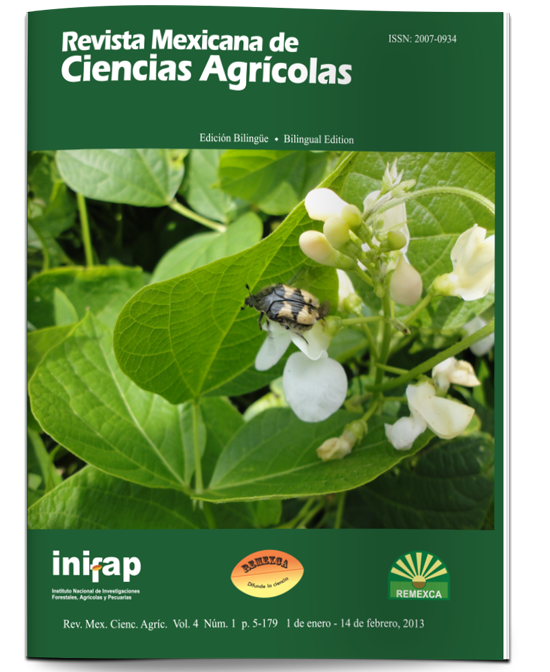Reaction to angular leaf spot and bean genotypes productivity with and without fungicide application
DOI:
https://doi.org/10.29312/remexca.v4i1.1269Keywords:
Phaseolus vulgaris L., Phaeoisariopsis griseola, genetic resistance, chemical protectionAbstract
In central Veracruz, the angular leaf spot is a disease that affects bean yield. The purpose of the study was to determine the reaction to this disease, yield and profitability of bean genotypes with and without application of the fungicide mancozeb. The experiment was set up in the rainfed in 2011 in Rincón Grande, Orizaba, Veracruz, in a randomized block experimental design with four replications in factorial arrangement of treatments. We evaluated two mancozeb levels: 0 (control region) and 1.5 kg ha-1 of commercial product and three bean genotypes: Negro Michigan (regional control) and the varieties Negro Jamapa and Negro Comapa. We measured the angular leaf spot and grain yield, which were analyzed and for the average separation we applied DMS at 0.05. We also performed a correlation analysis of both variables and an economic analysis to determine the profitability of the treatments. Without any fungicide application, the angular leaf spot decreased the yield (r= -0765 **). Negro Comapa and Negro Jamapa were tolerant to the disease and showed a better yield than Negro Michigan, which was susceptible. With the application of mancozeb, the plants showed less damage, an increase in yield higher than 800 kg ha-1 and higher profitability in the three genotypes, without fungicide application. With Negro Comapa and Negro Jamapa we obtained benefit/cost relations of 2.69 and 2.67, quite higher than Negro Michigan (1.91).
Downloads
Downloads
Published
How to Cite
Issue
Section
License
The authors who publish in Revista Mexicana de Ciencias Agrícolas accept the following conditions:
In accordance with copyright laws, Revista Mexicana de Ciencias Agrícolas recognizes and respects the authors’ moral right and ownership of property rights which will be transferred to the journal for dissemination in open access. Invariably, all the authors have to sign a letter of transfer of property rights and of originality of the article to Instituto Nacional de Investigaciones Forestales, Agrícolas y Pecuarias (INIFAP) [National Institute of Forestry, Agricultural and Livestock Research]. The author(s) must pay a fee for the reception of articles before proceeding to editorial review.
All the texts published by Revista Mexicana de Ciencias Agrícolas —with no exception— are distributed under a Creative Commons License Attribution-NonCommercial 4.0 International (CC BY-NC 4.0), which allows third parties to use the publication as long as the work’s authorship and its first publication in this journal are mentioned.
The author(s) can enter into independent and additional contractual agreements for the nonexclusive distribution of the version of the article published in Revista Mexicana de Ciencias Agrícolas (for example include it into an institutional repository or publish it in a book) as long as it is clearly and explicitly indicated that the work was published for the first time in Revista Mexicana de Ciencias Agrícolas.
For all the above, the authors shall send the Letter-transfer of Property Rights for the first publication duly filled in and signed by the author(s). This form must be sent as a PDF file to: revista_atm@yahoo.com.mx; cienciasagricola@inifap.gob.mx; remexca2017@gmail.
This work is licensed under a Creative Commons Attribution-Noncommercial 4.0 International license.



